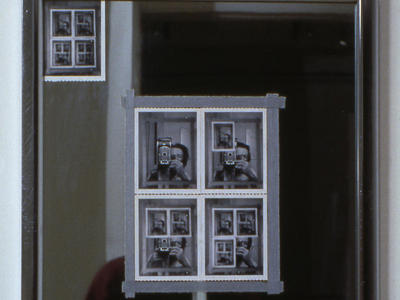
EYE WEEKLY - 11 / 17 / 2010
Conceptual Art Clarified
An epic exhibition reveals how, between 1965 and 1980, the most powerful Canadian art had little to do with paint and everything to do with thought.
—
When the original founders of Nuit Blanche first described their dusk-to-dawn extravaganza, they dubbed it a visual culture “thing,” making it clear that art today far exceeds the confines of a canvas or a museum’s walls; it has become amorphous, unobvious and concept-driven. Increasingly, art is about performance and spectacles, which tend to be live or found on video. How did painting and sculpture lose their importance? Whatever happened to beauty? When did it all get so weird?
One of the most compelling, groundbreaking and epic exhibitions to be mounted in years, featuring over 500 works of art at four venues across the city (the Justina M. Barnicke Gallery, the University of Toronto Art Centre, the Blackwood Gallery and the Doris McCarthy Gallery), “Traffic” addresses these questions. It’s a mesmerizing presentation of how, between 1965 and 1980, the most powerful Canadian art had little to do with paint and everything to do with thought. Well worth the visit, you’ll want to see the exhibition soon, as it closes on November 28. To help you navigate the show, EYE WEEKLY spoke with its curator, Barbara Fischer, who shared her picks of three works that changed the course of art.

Michael Snow, Authorization, 1969
MICHAEL SNOW, AUTHORIZATION 1969
“Here, Michael Snow, positioned before a mirror, makes visible the operations of the artist and shows you how his work is made,” says Fischer. “Up to the Second World War, industrialism was what drove most of the economy. Then ideas became more important than the reproduction of industrial labour. Authorization reflects this new world and how suddenly the exchange and tweaking of information — including the repetition and organization of photographs — became paramount.”

Lisa Steele, Juggling, 1972
LISA STEELE, JUGGLING, 1972
“This work, in which the artist trains herself to juggle,” says Fischer, stands out because “by the 1960s, art became about understanding the information age.” Instead of picking up the paintbrush to interpret their world, artists turned to contemporary tools including the video camera. Juggling is emblematic of how artists represented a new world with a new medium. “It also pre-visions what has happened on YouTube,” says Fischer, “and how we live in a world of people learning and demonstrating online, constantly trading knowledge and showing skills.”

Gordon Lebredt, Get Hold of This Space, 1974
GORDON LEBREDT, GET HOLD OF THIS SPACE, 1974
“Should artists produce more objects when the world is already so full of them?” Fischer asks in order to explain this work that can be peeled off and made to disappear. Once ’60s counter-culture unravelled the traditional bonds of society, it wasn’t long before artists like Gordon Lebredt were questioning the purpose of the museum. As Fischer says, this work asks, “How should we possess space?” and “What kind of footprint should we leave with art?”
When is Art About the Idea:
How to Enjoy It
1. Forget about conventional ideas about beauty or technical difficulty when you consider what art is. These are concepts that belong to the past.
2. Think about each work as an artist’s interpretation of the current world and don’t be bothered by the fact that it may feel strange. The work is about interpreting something that hasn’t yet been figured out.
3. Embrace what you don’t know. The artist, through his or her art, is asking you to help answer unsolved questions.
4. Resist saying to yourself, “I could have made that.” As Fischer explains, people talk about creativity, “but don’t know what the costs of creativity are.”
5. Ask, talk, and read. Conceptual art is not about universal beauty. It requires language to be understood.